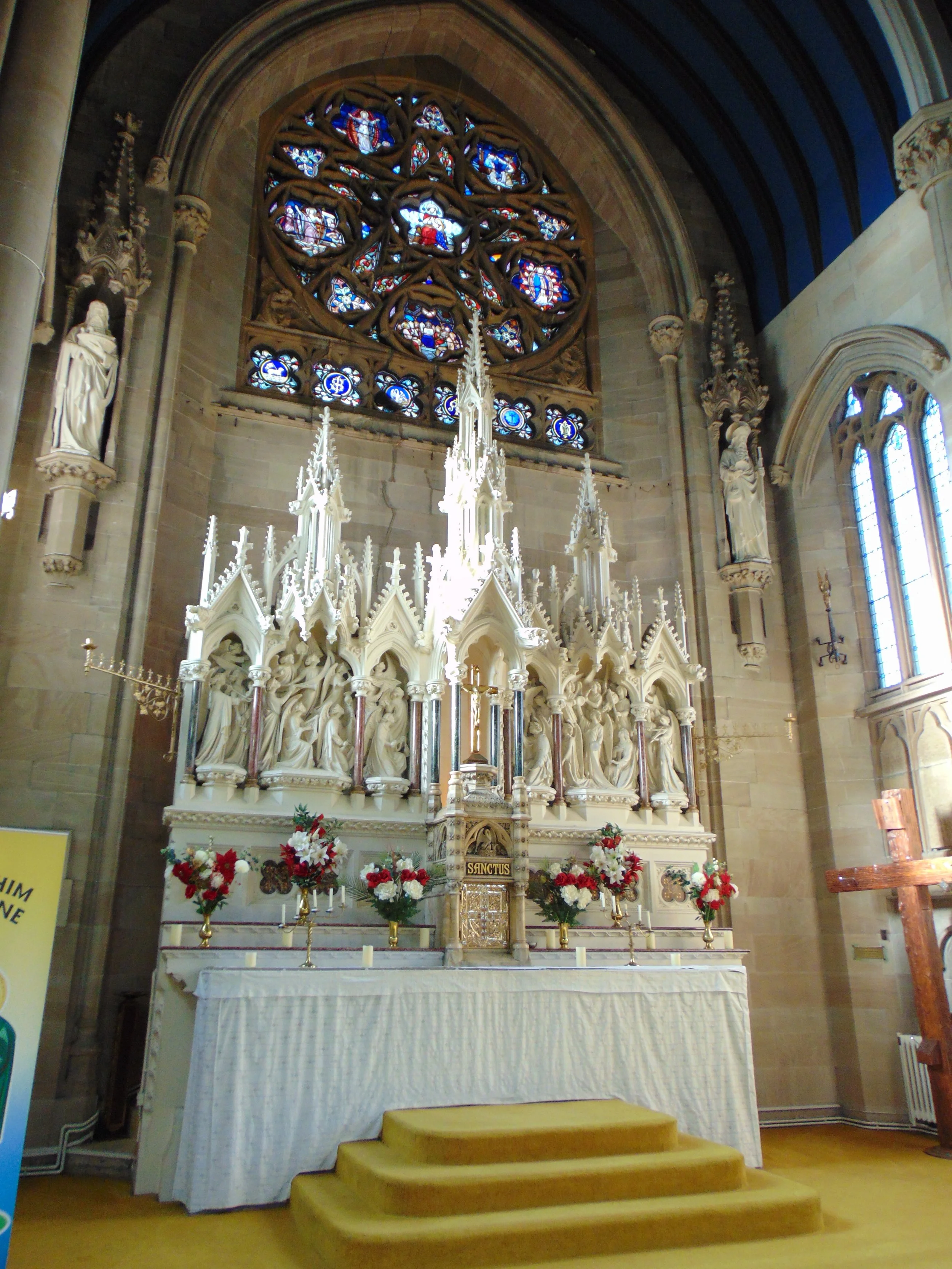The main altar
Reredos of the main altar
The tabernacle, the receptacle for the reserved Blessed Sacrament, is of alabaster with a polished brass door set with cabochon rock crystals. Surrounding it on three sides are Old Testament scenes carved in low relief. On the left, the Gospel side, is the sacrifice of Melchisedech, on the right, the Epistle side, shows Abraham and the boy Isaac, both foretelling Christ’s sacrifice; in the centre the tympanum above shows the pelican piercing its breast to feed the young with its own blood, symbolising Christ’s blood shed for mankind and also the Eucharist. Under each scene in large gold letters is the word ‘Sanctus’.
The altar cross stands on a pedestal, or throne, also of alabaster. The corpus on the crucifix is probably ivory and the cross is of polished bronze probably of a set with six large sanctuary candlesticks.
On either side of the reredos are scenes, carved in high relief, portraying angels with thurifers, trumpets, cymbals, and stringed instruments bringing to mind the 150th psalm, ‘Praise the Lord in His sanctuary’.
The canopy has three octagonal spires supported by slim columns of red marble. The tallest spire, the central one reaches to the lower part of the stained glass ‘Rosary’ window.
The design of the reredos is typical of Peter Paul Pugin’s ‘Benedictine’ altars with a prominent central throne above a tabernacle for the exposition of the Blessed Sacrament, and a wooden staircase behind for the priest to place the monstrance on the throne.
150th Psalm
Praise the Lord in His sanctuary,
Praise Him in the firmament of His strength,
Praise Him for His mighty deeds,
Praise Him for His sovereign majesty
Praise Him with the blast trumpet,
Praise Him with the lyre and the harp,
Praise Him with timbre and dance,
Praise Him with strings and pipe,
Praise Him with sounding cymbals,
Praise Him with clanging cymbals,
Let everything that has breath praise the LORD!
Alleluia.
Altar furniture
The bishop’s seat, at the present in the Lady Chapel, three seats in a row, the middle is the presidential chain, and a bench or sedilia are all of pitch pine and of a similar design to furnishings in the presbytery and so were almost certainly made by Cuthbert Pugin, half brother of Peter Paul Pugin at his firm the Southeast Furniture Company.
Sanctuary candlesticks
The six polished bronze candlesticks decorated with grapes and vine leaves are an unusual design and were donated by the Christian Young Men’s Society for the centenary of the church in 1962.
The altar rails
With the changes to the liturgy after the Vatican II Council, the altar rails were no longer needed and were removed from the front of the sanctuary and two sections were replaced at the sides.
The rails were designed by Charles HC Purcell, a grandson of AWN Pugin and a partner in the family firm, Pugin and Pugin. They were constructed of coloured marble with panels of small, coloured mosaics and were erected in 1932.
The four panels depict symbols of Christ and the Eucharist. The aureole, an almond shaped halo completely surrounding all, signifies divinity and is usually seen around the figures of Christ particularly at his Ascension or the Blessed Virgin Mary at her Assumption.
Grapes hanging from a branch of vine all surrounded by an aureole
A symbol of the Eucharist.
At the Last Supper Christ took a cup of wine made from the fruit of the vine saying that it was His blood which would be shed for many for the forgiveness of sins. (Matthew 26:26-28)
A vine and vine leaves are symbols of Christ himself ‘I am the true vine’. (John 15:1) Grapes hanging from a branch of the vine are a symbol of Christ hanging on the Cross.
Sheaf of corn surrounded by an aureole
A symbol of the Eucharist.
Corn is milled for flour and used for making bread; Christ offered bread as His body at the Last Supper when instituting the Eucharist. (Matthew 26:26-28)
Water turned into wine; the scene surrounded by an aureole
Symbol of the Eucharist.
Water and wine mingled are changed at the Consecration into the Blood of Christ.
The scene also symbolises the Marriage Feast at Cana when Christ first showed his miraculous power to mankind when he changed water into wine. (John 2:1-11)
Lamb with cruciform halo and a banner of with red cross all in an aureole
The lamb, a sacrificial animal, with a cruciform halo symbolises Christ and the cross with a flag bearing red cross symbolises victory over death.





